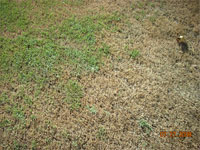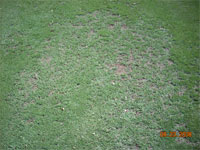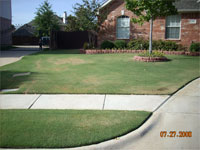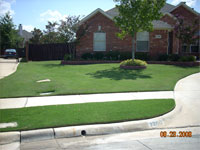Battling Take-All Root Rot

Before Treatment

After Treatment
A fungus-related disease that turf specialists and homeowners have encountered in St. Augustine lawns in Texas and other parts of the South for a number of years is now showing up in hybrid bermuda lawns. Last month, a caller to Neil’s radio show — Lance, from Keller — described distressing discoloration in his prized 419 bermuda lawn. His question: Could the problem be caused by bermuda mites?
Lance was obviously a conscientious homeowner who took great care of his lawn and had already tried a number of cures. Neil suspected the problem was TARR (take-all root rot) and asked for photographs. Then he contacted one of his favorite experts, Dr. Phillip F. Colbaugh, retired plant pathologist from Texas A&M Research Center in Dallas.
Yes, Phil Colbaugh responded, the spots shown in the photos “are typical of the ETRIF [ectotrophic root-infecting fungi] causing Bermudagrass Decline on this hybrid bermudagrass lawn…. These yellow patch areas (just like St. Augustinegrass) are active zones where the fungus is producing toxins that migrate upward to the flag leaf of the whorl because the oldest leaf transpires the most water, etc.”
Dr. Colbaugh and his colleages have done a great deal of research on ectotrophic root-infecting fungi and the assortment of turf diseases they cause. (Interested readers can see research details at www.plantanswers.com/root_rot_fungus.htm.) One of their goals has been “to develop a practical control measure” for affected landscapes. They have investigated a number of fungicides and also some top-dressing procedures. (For example, they compared peat moss top dressings with manure compost top dressings.)

Before Treatment

After Treatment
Dr. Colbaugh’s recommendation for Lance’s lawn: “This lawn should respond well to the peat moss treatment, but you have to do something special with these very dense-textured canopies on the hybrid Bermudas. To get the peat to settle in, you have to use the fine cut peat.” He explained further, “This is the peat the greenhouse growers use for filling tiny depressions in miniflats to grow seedling crops. Anyway, the peat is fine enough that you can apply a light topdressing and either brush it in or water it in with a strong water stream or fan nozzle set at high pressure.”
Neil explains that Canadian peat (with a pH of 4.4) helps to lower the pH of the affected soil, thus controlling the fungus, which seems to have an aversion to lower pH levels. Dr. Colbaugh’s research website has recommended one 3.8 cu. ft. bale per 1,000 square feet of lawn.
These recommendations were forwarded to Lance, who took the bull by the horns, immediately purchased fine-cut peat and treated his lawn. This week his e-mails to Sperry Gardens brought the “before” and “after” photos shown here. Neil took the occasion to congratulate both Phil Colbaugh and Lance in Keller — and to share this success story with e-gardens readers.
